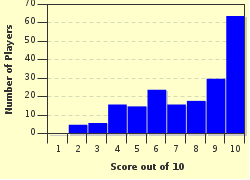Quiz Answer Key and Fun Facts
1. Perhaps the most enduring characteristic of the Hmong historically has been their refusal to assimilate and give up their traditional identity and customs. One classic historical example of this is the repeated exhortation of Chinese officials who continually bemoaned that the Hmong "didn't even use chopsticks."
2. Through their turbulent history, the Hmong have found themselves scattered around Asia - and, more recently, other parts of the world. Which of these countries had the least Hmong population at the beginning of the twentieth century?
3. The Hmong's traditional economic practices in Asia included swidden farming, also known as slash-and-burn agriculture, where the refuse of a crop was burned in the field following harvest. As this tends to wear out soil very quickly, the Hmong developed a migrant existence, and entire villages often moved every few years. Since the 1800s, one crop came to dominate this cycle, and this liminal commodity still occupies a major place in the lives of many Hmong. What crop is this?
4. After World War II, Southeast Asia became a political battleground between ideologies. Which of these forces did the Laotian Hmong (exclusive of the Lo clan, which did the opposite) generally support?
5. During the United States' war against Vietnamese Communists, the American CIA enlisted large numbers of Hmong to stage an insurrection against the Laotian Communist government, known as the Pathet Lao. Who was the most important commander of the CIA-sponsored Laotian Hmong?
6. Though generally an effective fighting force, the anti-Communist Hmong army was ultimately unsuccessful in their efforts against the Pathet Lao. In what year did this army disband, effectively ending the Secret War?
7. Following unsuccessful Hmong revolts and communist depredations in retribution (including chemical warfare), masses of Laos' Hmong fled the country. What was the immediate destination for the bulk of these refugees?
8. Given that their support of American efforts in Southeast Asia was to blame for the Hmong's persecution in Laos, thousands of refugees eventually emigrated to the United States. Which of these areas would NOT become a major center of Hmong life in the US?
9. Since the end of the Cold War, the Hmong émigré community in the United States has reached an accord with the Pathet Lao, and relations between the two can be described as cordial and accommodating.
10. Over time, Hmong émigrés and their children have forged a Hmong-American culture increasingly distinct from the Hmong of Asia. Along the way, there have been a number of cultural clashes, leading to enmity between many American Hmong and their neighbors. Which of these conflicts has gained national publicity in the 21st century?
Source: Author
stuthehistoryguy
This quiz was reviewed by FunTrivia editor
bloomsby before going online.
Any errors found in FunTrivia content are routinely corrected through our feedback system.

